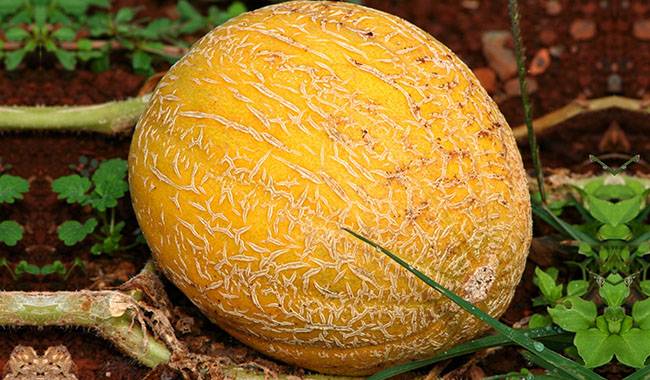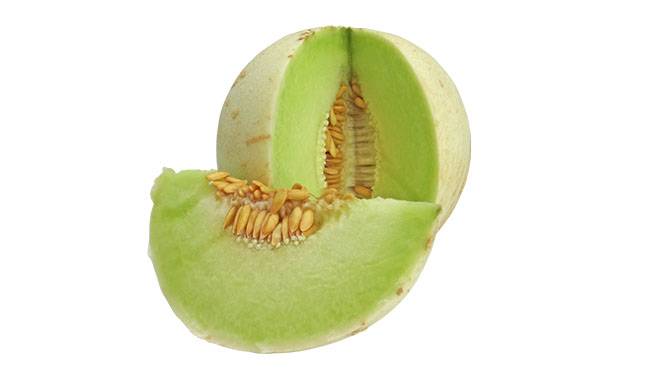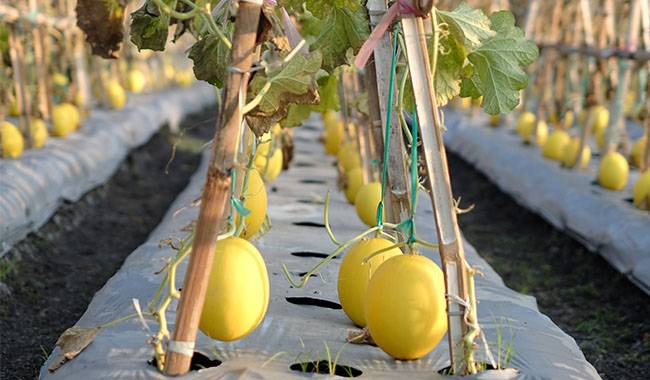
How to plant honeydew seeds? Honeydew is easy to grow from seeds and can be grown from store-bought honeydew seeds, although the honeydew grown from these seeds may be smaller or otherwise inferior to the original honeydew due to cross-pollination in the field where the original honeydew was grown.
PLANTING METHOD
Direct sowing of honeydew in the garden
In areas where the growing season lasts more than 120 days, honeydew can be sown directly in the garden.
honeydew seeds germinate best in warm soil, with the optimum soil temperature for germination being around 77°F (25°C).
Covering with black plastic film and opening holes for individual melon plants allows the soil to warm up faster and promotes early growth and fruiting of melon plants.
Honeydew vines are sprawling, leaving enough space. honeydew can be planted either singly in rows or in groups.
Start honeydew seeds indoors
To get a head start on honeydew or areas with a short growing season, start transplants from seed indoors 3 to 4 weeks before the frost-free season.
Plant the seeds one inch deep in the sterile seed-starting medium.
honeydew does not like root disturbance, so start transplants in a separate container or peat pot. A heating pad or a warm germination location can promote early germination.
The roots of honeydew grow quickly, so be sure to use a large enough starting container.
A 2-inch diameter pot or 6-ounce yogurt cup with drainage holes will hold honeydew seedlings for 3 to 4 weeks, but leaving the plants in that size container will become rooted and last longer.
When honeydew seedlings have 2 sets of true leaves, thin out the strongest seedlings in each container.
After all danger of frost has passed, plant into the garden at the recommended final spacing on the hill or between the rows.
Apply a starter fertilizer at transplanting to give the honeydew seedlings a strong start.
Plant honeydew from seed on hills
In a hill system, plant groups of multiple squash vines. groups of 2 plants are spaced 36 inches apart and groups of 3 plants are spaced 48 inches apart.
The hills do not need to be elevated, but they should have plenty of organic matter entering the soil. Plant 5-6 seeds on each hill.
When the seedlings have 4 leaves, select the best 2 or 3 seedlings on each hill and cut the rest at soil level with scissors or small garden pruners.
Growing honeydew from seed in rows
In a row system, single honeydew plants are planted in rows at 18- to 24-inch intervals at least 5 feet apart to allow for vine runs.
As with hills, there should be plenty of organic matter between the rows. Plant seeds 12 inches apart and when they have four true leaves, thin to the strongest seedlings 18 to 24 inches apart.
Care for the honeydew growing from seed
Honeydew plants require little additional fertilizer when a large amount of well-rotted manure is processed into the soil before planting or transplanting.
When honeydew starts to run vines, apply high nitrogen fertilizer for side-dressing to promote good growth of honeydew, but avoid excessive nitrogen fertilization.
Honeydew plants also thrive when high potassium fertilizer is applied. A steady supply of water, which decreases as the melons begin to ripen, ensures optimal flavor and the healthiest plants.
SOW AND START
Honeydew performs best in warm weather. The soil needs to be warm and dry, so plant it after the danger of frost has passed.
Some gardeners plant cantaloupe and honeydew through holes in landscape fabric or black plastic. the material traps heat and heats the soil at the start of the season to encourage growth. The fabric also keeps the vines clean and discourages weeds.
In areas where the cold persists, move the seeds indoors for three to four weeks before moving them outdoors. Use individual peat containers to avoid disturbing the roots.
Plant squash in a 6-12inch (15.24-30.48cm) mound. Sow 3-5 seeds 2inch (5.08cm) apart and about 1inch (2.54cm) deep. Space the mounds 2 ft (60.96 cm) apart and each row 5 ft (152.4 cm) apart.
When seedlings germinate, thin them out to 18-24inch (45.72-60.96cm) apart. honeydew vines take up a lot of space and the distance allows for free air circulation.
Apply a general-purpose fertilizer every two to three weeks. Cantaloupe and honeydew benefit from a weakly acidic soil with a pH of 6.0 to 6.5. Each month, add a few inches of compost to the root zone.
honeydew trees need a lot of water, so give them up to two inches of water per week. Trickle irrigation at the soil level is best. Water honeydew in the morning, so the leaves are dry by evening. This helps prevent fungal diseases.
Both male and female cantaloupe flowers grow on the same squash tree, and bees are necessary for pollination and subsequent fruit set. The first flowers are male flowers.
They are unable to produce fruit and will shed. The female flowers appear in a short time. After the bees pollinate them, the small bulbs at the base of the bloom will grow into a honeydew.
If space is limited, cantaloupe and honeydew can be trained to grow out of a lattice or hedge. Use soft ties to hold them in place. Soon after the melons start growing, support them with mesh bags tied to the lattice. Otherwise, their weight may strain or pull down the honeydew tree.
Prevent ripe melons from touching the ground. Supporting them with mulch, pots or other similar items helps prevent rot and pests.
HOW TO GROW
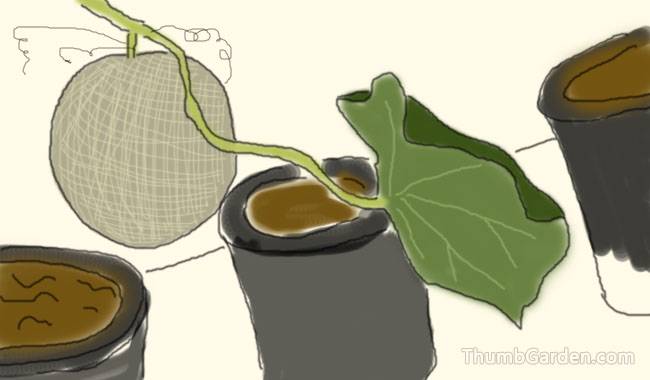
Control weeds during the growing season. Weeds compete with plants for water, space, and nutrients, so cultivate or use mulch frequently to control them and prevent their seeds from germinating.
Honeydew has a shallow root system and mulch helps retain soil moisture and keep soil temperatures even.
Keep plants well hydrated during the growing season, especially during dry periods. During the growing season, plants need about 1-2 inches (2.54-5.08 cm) of rain per week.
Use a rain gauge to check if water needs to be added. It is best to water using a drip or trickle system to deliver water to the soil at low pressure.
If you water with an overhead sprinkler, water early in the day so that the leaves have time to dry out by evening to reduce disease problems. Keep the soil moist but not saturated.
Mulch when plants are growing to control weeds, keep fruit off the ground and conserve moisture. Do not move vines, which can be easily injured.
Monitor for pests and diseases. Check with your local Cooperative Extension Service for recommended pest and disease control methods in your area.
GROWTH TIPS
HARVESTING TIME
Most melons ripen in late summer or early to mid-fall. Each honeydew usually gets two to three melons. Their sweetness depends heavily on the three weeks before harvest. Water sparingly during that time, as dry conditions promote sweetness.
Honeydew is very fragrant when it is ready for picking. The stems easily detach or slip off the fruit. The green webbed rind turns brownish. Sugar growth comes from enough time on the vine to ripen.
Do not select them too early. The sugar is kept in the melon until the stems separate. After picking, they soften but do not sweeten further.
When the rind turns creamy white, it is time to harvest honeydew. They will be slightly softer at the end of flowering and honeydew will not slide off the vine, so they need to be cut off with scissors. After picking, they will mature at room temperature for a few days.
Honeydew and melons are harvested in the morning after the dew has dried. Pick them at the beginning of the harvest and every other day of the season on alternate days. Otherwise, wildlife and insects may enjoy some sweet crops.
COMMON PESTS AND DISEASES
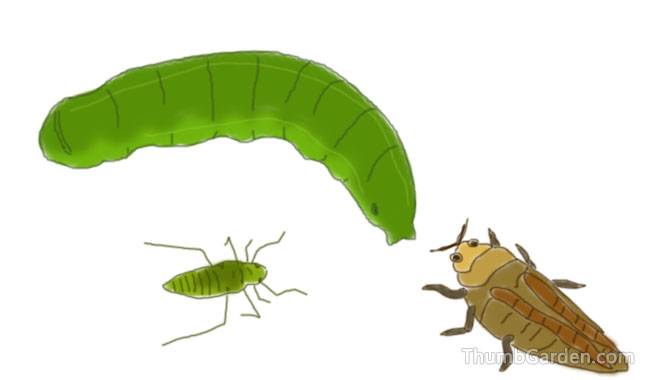
Common disease problems
Streptomyces interrogans leaf spot
Small, round, reddish-brown spots, usually with a yellow halo, form on the upper surface of the leaves. Severely infected leaves turn brown, curl upward, shrivel and die.
Fruits are usually not infected but may suffer from sunlight as the leaves fall off. The disease is more severe in warm, humid, or very wet weather.
Advice: Avoid getting water on branches and leaves. Remove infected plant parts and do not work near wet plants. Provide adequate air circulation. Contact your cooperative extension service for fungicide recommendations.
Anthracnose
This is a fungal disease that strikes when the fruit is ripe. Irregular brown spots appear on the leaves.
Infected fruit will develop sunken black spots that may carry white mycelium in wet weather. The spots expand and turn black; the fruit rots. Prolonged heat and humidity promote the growth of anthracnose. The fungus overwinters in the remains of diseased plants.
Recommendations: leave enough space between plants to ensure good air circulation, avoid overwatering to avoid spreading fungal spores, keep your garden clean, remove and discard all diseased plant material and rotate crops.
Bacterial wilt
Leaves turn brown, stems wilt and die and infected plants die. Recommendations: Remove and destroy plants showing signs of the disease. Control cucumber beetles, which spread the disease. Please contact your cooperative extension service for advice.
Powdery mildew
In wet weather conditions, this fungal disease occurs on the tops of the leaves. The leaf surface becomes white or gray and may curl.
Suggestion: Avoid powdery mildew by providing good air circulation to plants through good spacing and pruning. Please contact your cooperative extension service for fungicide recommendations.
Seed rot and damping-off
This is a fungal disease that affects seeds and seedlings. Infected seeds will not be sprayed. Infected seedlings may have thin brown stems and the plant will die quickly.
Recommendation: Do not plant seeds until the soil temperature rises to 65°F (18.3°C). Plant seeds on high rising hills, which will get hotter sooner. Keep the bed moist, but do not fill it with water.
Common pest and disease problems
Aphids
Green, red, black, or peach sucking insects can spread disease when feeding on the underside of the leaves.
They leave a sticky residue on the leaves that attract ants. Recommended: Introduce or attract natural predators to your garden, such as ladybugs and wasps that feed on aphids. You can also wash them off with a strong spray, or use insecticidal soap.
Cucumber beetles
Beetles may be spotted, striped, or banded and can be very harmful. The beetles are usually ¼ to ½ inch in size.
Beetles begin feeding immediately after hatching and can kill or slow plant growth. Beetle larvae can penetrate the roots of plants. Beetles can also spread disease among plants.
Suggestion: Knock the adults into a jar of soapy water and destroy them. Before planting, shovel the soil to destroy dormant beetles. Use row covers to prevent adults from feeding on young plants. For insecticide recommendations, consult your Cooperative Extension Service.
Fruit splitting
This indicates that when the fruit forms, it does not receive an even supply of water from the roots. The sudden onset of summer storms causes the stems to suddenly gush with water that can pop out of the skin of the ripe fruit like a ripe water bladder.
This condition is especially noticeable after a drought when summer storms deliver large amounts of water to the fruit’s tissues. The skin does not swell fast enough and splits.
Advice: Water carefully: Instead of a quick daily sprinkle, water deeply once or twice a week (depending on rainfall) so that the water soaks deeply into the soil and the roots can absorb the water as needed.
A hose soaked in water will help. Stick your finger in the soil daily to check that it is evenly moist a few inches below the surface.
Squash bugs
Adult squash bugs are 5/8 of an inch long and gray or brown in color. When squashed, squash bugs give off an unpleasant odor. Young wigglers have light green abdomens and blackheads and legs.
As the worms grow, they change color. Eggs are found in clusters on the underside of leaves. The eggs will be yellow or brown. Squash bugs will feed on leaves and fruit.
Suggestion: Use a brush to rub adults into a jar of soapy water and destroy them. Inspect the back of the leaves for egg clusters and destroy them. Use floating row covers to prevent females from laying eggs on the plant.
Spider mites
These tiny, spider-like pests are about the size of the pepper. They may be red, black, brown, or yellow.
They absorb plant sap, removing chlorophyll and injecting toxins that cause white spots on the leaves. Webbing is often visible on plants.
They cause leaves to turn yellow and become dry and blotchy. They multiply rapidly and grow strongly in dry conditions.
Suggestion: Every other day you can control spider mites with a powerful spray. Try pepper wax or insecticidal soap. Contact your cooperative extension service for advice on miticides.
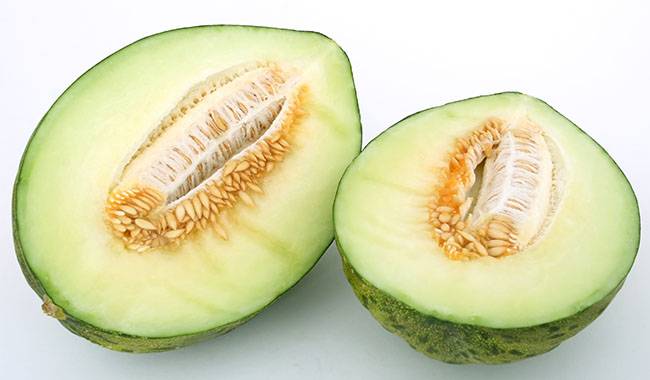
Hahoneydew FAQ
Why do I have flowers but no fruit?
Honeydew is “monoecious”, which means they have both male and female flowers on the same plant. The male flowers usually bloom first, and the female flowers are followed by the baby fruit.
Both types of flowers must be present to bear fruit. Flowers may abort due to heat, cold, or drought stress, or flowers may abort due to lack of pollination;
Or the plant is not ready to set fruit and the plant is self-priming the flowers to conserve and direct energy for more growth.
Why do I have a lot of leaves but no flowers?
The plant may be taking up too much nitrogen, which causes it to grow leaves, and not enough phosphorus, which favors flowering and fruiting.
Choose a fertilizer that has a balanced ratio of the three main elements, such as 10-10-10, or one where the middle number (phosphorus) is greater than the first number (nitrogen).
Why do my fruits have a bitter taste or poor flavor?
Bitterness can be caused by a number of factors including dry heat temperatures, overwatering, or poor soil fertilizer.
Honeydew has lighter roots. Make sure the soil is moist but never waterlogged. Test your soil for nutrient deficiencies.
Can I ripen fruit from honeydew trees?
Unfortunately, no. The fruit is ripe the moment you pick it.
How many melons do I want per plant?
Limit your fruit to 3-4 per plant. the more fruit the honeydew tree supports, the smaller the fruit, the longer it will take to ripen.




